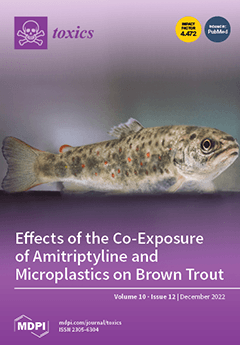Sodium Dodecyl Sulfate (SDS) is an anionic surfactant, extensively used in detergents, household and personal care products, as well as in industrial processes. The present study aimed to disclose the potential toxicological effects of SDS exposure under environmentally relevant concentrations (0, 0.1, 1,
[...] Read more.
Sodium Dodecyl Sulfate (SDS) is an anionic surfactant, extensively used in detergents, household and personal care products, as well as in industrial processes. The present study aimed to disclose the potential toxicological effects of SDS exposure under environmentally relevant concentrations (0, 0.1, 1, 3, and 10 mg L
−1) on the physiology and biochemistry (photosynthesis, pigment, and lipid composition, antioxidative systems, and energy balance) of two marine autotrophs: the diatom
Phaeodactylum tricornutum and the macroalgae
Ulva lactuca. A growth rate (GR) reduction in
P. tricornutum was observed with a classic dose-response effect towards the highest applied concentration, while a GR increase occurred in
U. lactuca. Regarding photochemistry, the decrease in the fluorescence of the OJIP curves and laser-induced fluorescence allowed a better separation between SDS treatments in
U. lactuca compared with
P. tricornutum. Although all pigments significantly decreased in
U. lactuca at the highest concentrations (except for antheraxanthin), no significant variations occurred in
P. tricornutum. On the other hand, changes in fatty acid content were observed in
P. tricornutum but not in
U. lactuca. In terms of classical biomarker assessment, a dose-effect relationship of individual biomarkers versus SDS dose applied;
U. lactuca displayed a higher number of biomarker candidates, including those in distinct metabolic pathways, increasing its usefulness for ecotoxicological applications. By evaluating the potential application of optical and biochemical traits, it was evident that the fatty acid profiles of the different exposure groups are excellent candidates in
P. tricornutum, concomitant with the characteristics of this anionic surfactant. On the other hand, the results presented by laser-induced fluorescence and some parameters of PAM fluorometry in
U. lactuca may be an advantage in the field, offering non-invasive, fast, easy-to-use, high-throughput screening techniques as excellent tools for ecotoxicology assessment.
Full article






